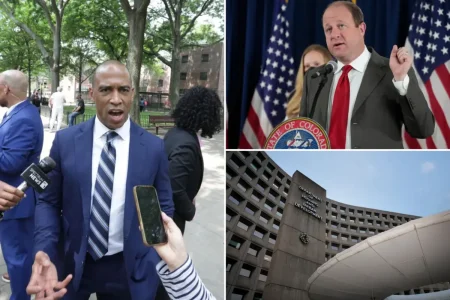Off-Duty Deputy Involved in Fatal Shooting During Alleged Car Break-In
In a tense confrontation that ended tragically, an off-duty Harris County deputy fatally shot 27-year-old Darrius Williams, who allegedly attempted to enter the deputy’s vehicle while the officer’s young child sat in a car seat. The incident occurred Friday afternoon in Atascocita, a community about 20 miles northeast of Houston, when what should have been a routine moment—a parent securing their child in a vehicle—suddenly escalated into a deadly encounter. According to Harris County Sheriff Ed Gonzalez, the deputy called 911 around 2:45 p.m. to report that he was holding someone at gunpoint. Major Ben Katrib later explained that the confrontation began just after the deputy had placed his child in a car seat, when Williams, described as an “unknown man” to the deputy, allegedly tried to enter the vehicle despite receiving multiple verbal warnings to stop.
The situation quickly turned deadly when Williams reportedly ignored the deputy’s commands and opened the passenger door where the child was seated. Feeling threatened, the deputy fired multiple shots, striking Williams several times. Though first responders attempted to provide medical assistance at the scene, Williams later died at the hospital. Authorities have confirmed that neither the deputy, whose identity has not been released, nor his child sustained any physical injuries during the frightening encounter. The investigation is still in its preliminary stages, and officials have not yet disclosed whether Williams was armed at the time of the incident or precisely how many times he was shot. Sources indicated that Ring doorbell camera footage may have captured the confrontation, potentially providing crucial evidence as investigators piece together the exact sequence of events.
The incident has raised questions about mental health intervention and law enforcement responses, particularly after Williams’ mother, Tieneeshia, revealed crucial context about her son’s circumstances. According to her account, her son had been released from jail just the night before the shooting and had been struggling with significant mental health issues. She described a troubling interaction with police that preceded this incident, explaining that officers had detained her son for “walking into oncoming traffic” but chose to process him for an outstanding warrant rather than taking him to a psychiatric facility as she had requested. “The officer called me when she was there with him on the scene and asked me a lot of questions, and I said, ‘Ma’am, why don’t you just take him to the psychiatric ward. He’s walking into traffic.’ She said, ‘Oh no, we’re going to deal with this warrant, he’s going to jail,'” Tieneeshia Williams recounted, suggesting a missed opportunity for mental health intervention that might have prevented the subsequent tragedy.
For many familiar with law enforcement procedures, this incident highlights the split-second decisions officers must make when faced with perceived threats, especially when children are involved. The deputy, confronted with someone attempting to access a vehicle containing his child, responded with lethal force—a reaction that will now be scrutinized through formal investigative channels. The case underscores the complex intersection of public safety, mental health crises, and use of force policies that communities across America continue to grapple with. When individuals in mental health crisis encounter law enforcement, the outcomes can be unpredictable and, as in this case, sometimes fatal, raising important questions about appropriate responses and available resources for both officers and those experiencing psychiatric emergencies.
The confrontation between Williams and the deputy represents just one of many similar incidents that have occurred nationwide, where encounters between civilians and law enforcement—whether on or off duty—have resulted in fatalities. Each such case brings renewed attention to policies governing use of force, officer training, mental health response protocols, and the resources available in communities to address behavioral health crises before they escalate to dangerous situations. Williams’ mother’s testimony about her son’s recent jail release and untreated mental health issues points to potential gaps in the system that might have contributed to this tragic outcome. Her account suggests that just hours before the shooting, there may have been an opportunity for intervention that could have changed the course of events.
As the investigation continues, both the Harris County Sheriff’s Office and the Harris County District Attorney’s Office are conducting separate inquiries into the incident. These parallel investigations will examine the circumstances leading up to the shooting, whether appropriate procedures were followed, and if the use of deadly force was justified under the situation. The process is designed to be thorough and impartial, with the district attorney’s office ultimately planning to present their findings to a grand jury. This grand jury will then determine whether criminal charges should be filed against the deputy or if the shooting was justified under Texas law. Meanwhile, a community is left to mourn a life lost and to reflect on the circumstances that led to this confrontation—from Williams’ mental health struggles and recent release from jail to the terrifying moment when a parent felt compelled to use deadly force to protect a child.
In the aftermath of this tragedy, important questions remain about how society handles the intersection of mental health crises and law enforcement responses. Williams’ death adds to ongoing national conversations about alternative approaches to individuals experiencing psychiatric emergencies and the resources needed to prevent such confrontations before they turn deadly. As investigators gather evidence, review footage, and interview witnesses, families on both sides of this incident are dealing with its profound consequences—one mourning a son lost to violence, and another processing the trauma of a threat to their child and the heavy burden of having taken a life. Whatever the investigation ultimately determines about the legal justification for this shooting, the human cost is already clear and irreversible, leaving both families and the broader community to search for meaning and potential lessons in this tragedy.











